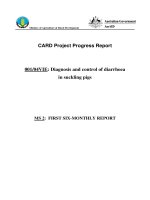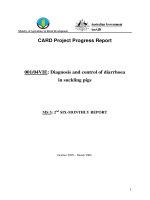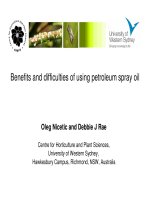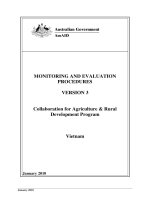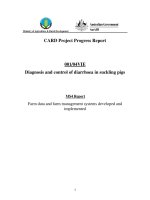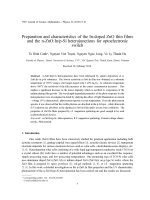Báo cáo nghiên cứu khoa học " HYDROLOGICAL AND SEDIMENTARY STRUCTURE OF THE WATER COLUMN IN THE BACH DANG - CAM ESTUARY " ppsx
Bạn đang xem bản rút gọn của tài liệu. Xem và tải ngay bản đầy đủ của tài liệu tại đây (422.95 KB, 4 trang )
Tiểu ban: Khí tượng, thủy văn và động lực học Biển
82
HYDROLOGICAL AND SEDIMENTARY STRUCTURE OF THE
WATER COLUMN IN THE BACH DANG - CAM ESTUARY
LEFEBVRE Jean-Pierre
1
, ARFI Robert
2
, CHU Van Thuoc
3
, DINH Van Uu
4
,
MARI Xavier
5
, PANCHE Jean-Yves
6
, TORRETON Jean-Pascal
5
,
VU Duy Vinh
3
, OUILLON Sylvain
1
1
UMR 5566-LEGOS, IRD, 14 av. Edouard Belin, 31400 Toulouse, France
2
UMR 6535-LOPB, IRD, 13288 Marseille cedex 09, France
3
Institute of Marine Environment and Resources, 246 Danang, Haiphong, Vietnam
4
Hanoi University of Science, VNU, 334 Nguyen Trai, Hanoi, Vietnam
5
UMR 5119-ECOSYM, IRD, Institute of Biotechnology,18 Hoang Quoc Viet, Hanoi,Vietnam
6
US 191-IMAGO, IRD, BP A5, 98848 Nouméa cedex, New Caledonia
E-mail: ,
Abstract:
The present study aimed to describe the hydrological functioning of the
Northern branch of the Red River estuary (Song Hong). This research results
obtained from the project "Hydrodynamic and anthropogenic influences on
phytoplankton and bacterioplankton of the Bach Dang estuary"(2008-2010)
funded by VAST, IRD and the French National Program EC2CO. A very
contrasted functioning was observed between wet and dry seasons. During the wet
season, the strong freshwater discharge dominated the flow, producing high
turbulence levels. During the dry season, as the steady fluvial component
weakened, the action of tidal intrusion became predominant with a significant
action of tidal pumping during the dry season which is responsible of a strong
silting up of the estuarine system.
Tóm tắt:
CẤU TRÚC TRẦM TÍCH VÀ THỦY HỌC CỦA CỘT NƯỚC
Ở VÙNG CỬA SÔNG BẠCH ĐẰNG - CẤM
Nghiên cứu này nhằm mục đích mô tả chức năng thủy học của nhánh sông phía
Bắc thuộc vùng cửa sông Hồng. Các kết quả nghiên cứu này có được từ dự án
"Ảnh hưởng nhân sinh và thủy động lực tới thực vật phù du và vi khuẩn nổi ở
vùng cửa sông Bạch Đằng" (2008-2010) do Viện Khoa học và Công nghệ Việt
Nam, Viện Nghiên cứu vì sự phát triển và Chương trình quốc gia EC2CO, Pháp
tài trợ. Có sự tương phản rất rõ về chức năng giữa mùa mưa và mùa khô. Vào
mùa mưa, dòng nước ngọt đổ ra mạnh chiếm ưu thế, gây ra các mức xáo trộn cao.
Trong mùa khô, do thành phần sông ổn định bị yếu đi, ảnh hưởng của sự xâm
nhập thủy triều trở nên chiếm ưu thế với tác động đáng kể của bơm thủy triều
trong mùa khô là nguyên nhân gây lắng bùn mạnh của hệ thống cửa sông.
Communication
In order to analyze the variability in the functioning of the Bach Dang-Cam estuarine
system at both the tidal and seasonal scales, two field campaigns were conducted, one in July
2008 (wet season ) and the other in March 2009 (dry season). During these two campaigns,
24-hours surveys corresponding to one spring tidal cycle were achieved at key spots of the
estuarine system. During every survey, the tidal elevation was approximately 2 m. Two
stations were located on the main rivers flowing into the Haiphong bay; one on the Cam
River, which is connected to the Red River, and one on the Bach Dang River, at about five
kilometers upstream to the mouth; the third station was located close to the mouth of the
system near Dinh Vu. Water fluxes and suspended solid averaged over one tidal cycle showed
high seasonal variations. Water discharge was about 4 times higher in the wet season than in
Hội nghị Khoa học và Công nghệ biển toàn quốc lần thứ V - Tiểu ban Khí tượng, Thủy văn và Động lực học biển
83
the dry season at each station. The budget indicated a water loss by leakage though channels,
mangroves and wetlands, which accounts for 20% and 42% of the liquid contributions of the
total inputs in the wet and dry season, respectively. These budgets also indicated that during
the wet season, the massive influx of sediment originated from the watershed passed through
the estuary with a weak loss by deposition or leakage. During the dry season, the quantity of
transported sediment was lower and the major input of sediment into the system came from
the coastal area. The estuarine domain was silting up whatever the season (with a settling rate
of approximately 2,400 metric tons per day in dry season, 3 times higher than deposit in wet
season)(Fig. 1).
Figure 1. Liquid flow budget Q (m
3
s
-1
) (left) and solid transport (metric tons day
-1
) (right)
during wet (black) and dry (white) season
Since the celerity of the tidal wave propagates faster with increasing water depth, the
shape of the tidal wave gets distorted for shallow estuary, where the difference in water height
is significant between ebb and flood. Due to their shape, large with shallow lateral shoals and
a deep narrow channel, as it moves landward toward the Cam and Bach Dag stations; the rise
of the tide becoming faster than its fall and, consequently, the current peak at flood faster than
the one at ebb. This asymmetry is referred to as ‘tidal pumping’ and causes the sediment to be
transported upstream. An elevation of the tidal level counterbalances the liquid budget so that
the overall balance of tidal flow is null. The upward solid flux is located near bed (Fig. 2).
Figure 2. Tidal (solid line) and advective (dashed line) sediment flux during the wet (black)
and dry (grey) seasons at the Cam (left), Bach Dang (center) and Dinh Vu (right) stations,
averaged over a tidal cycle
Different sources of perturbation can influence the structure of the water column (heat
flux, fresh water input, salt concentration, wind, rain…). The potential energy anomaly
(J.m
-3
) used to quantify the level of stratification, was calculated as [1]:
Tiểu ban: Khí tượng, thủy văn và động lực học Biển
84
h
gzdz
h
0
)(
1
(1)
where ρ is water density calculated according to the UNESCO 1983 polynomial formula, h is
the water depth, g is the acceleration of gravity and < > stands for averaging over the water
column.
As the water density is mostly related to the salt concentration, the saline intrusion driven
by tidal propagation contributes to the structure of the water column. The increase in potential
energy anomaly from wet to dry season is similar at the Bach Dang (x 7.96 ) and Dinh Vu
stations (x 7.26). Between these two stations, the proportionality factor varied little from one
season to another (x 0.88 in wet season, x 0.80 in dry season).The structuring is mainly
related to the marine water entries but can also depend on the weather conditions. Thus, the
Cam river, rather homogeneous in rainy season showed a vertical structure in dry season
during a short episode when wind speed was at its minimum.
Table 1. Potential energy anomaly
The turbulent kinetic energy dissipation rate (
: m
2
s
-3
) integrated over the water column
can be expressed as a function of wind and averaged current magnitude [2] :
h
w
k
h
u
k
sb
3
(2)
where k
b
and k
s
are the bottom and surface drag coefficients, <u> is the depth-averaged water
velocity, h is the water height, w is the wind velocity, and ψ the ratio between water and air
density.
High turbulence levels promote vertical advection of salt. It results a homogeneization of
the water colum that corresponds to low potential energy anomaly values. At the contrary,
near slack water of high tide, the low turbulence level does not influence significantly the
strong stratification induced by the presence of an upper layer of freshwater and a bottom
layer of marine water in the flow (Fig. 3).
Station
Wet season (July 2008)
Dry season (March 2009)
Mean
Min
Max
Mean
Min
Max
Cam
0.26
0.15
0.46
5.78
0.84
32.48
Bach Dang
4.79
0.04
31.14
38.15
5.35
81.63
Dinh Vu
4.22
0.00
20.66
30.64
7.69
69.18
Hội nghị Khoa học và Công nghệ biển toàn quốc lần thứ V - Tiểu ban Khí tượng, Thủy văn và Động lực học biển
85
Figure 3. Potential energy anomaly (solid line) and turbulent energy dissipation rate (dashed
line) during a tidal cycle at at the Cam (up), Bach Dang (center) and Dinh Vu (down) stations
during wet(left) and dry (right) season.
References
1. Simpson JH, Brown J, Matthews J, Allen G. Tidal Straining, Density Currents, and
Stirring in the Control of Estuarine Stratification. Estuaries 13(2):125-132 (1990).
2. Van der Lee EM, Bowers DG, Kyte E. Remote sensing of temporal and spatial patterns of
suspended particle size in the Irish Sea in relation to the Kolmogorov microscale. Cont
Shelf Res 29:1213–1225 (2009).
13:59 14:29 14:59 15:29 15:59 16:29 16:59
0
20
40
60
80
Time
Potential Energy Anomaly (J.m
-3
)
0
0.5
1
1.5
2
x 10
-4
turbulent energy dissipation rate (m
2
.s
-3
)
13:55 14:25 14:55 15:25 15:55 16:25 16:55
0
5
10
15
20
Time
Potential Energy Anomaly (J.m
-3
)
0
1
2
3
4
x 10
-4
turbulent energy dissipation rate (m
2
.s
-3
)
10:44 11:14 11:44 12:14 12:44 13:14 13:44
0
20
40
60
Time
Potential Energy Anomaly (J.m
-3
)
0
2
4
6
x 10
-4
turbulent energy dissipation rate (m
2
.s
-3
)
12:15 12:45 13:15 13:45 14:15 14:45 15:15
0.1
0.2
0.3
0.4
0.5
Time
Potential Energy Anomaly (J.m
-3
)
0
2
4
6
8
x 10
-4
turbulent energy dissipation rate (m
2
.s
-3
)
08:37 09:07 09:37 10:07 10:37 11:07 11:37
0
10
20
30
40
Time
Potential Energy Anomaly (J.m
-3
)
0
0.5
1
1.5
2
x 10
-4
turbulent energy dissipation rate (m
2
.s
-3
)
08:54 09:24 09:54 10:24 10:54 11:24 11:54
-10
0
10
20
30
Time
Potential Energy Anomaly (J.m
-3
)
0
2
4
6
8
x 10
-4
turbulent energy dissipation rate (m
2
.s
-3
)
